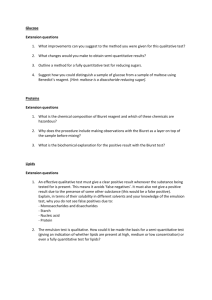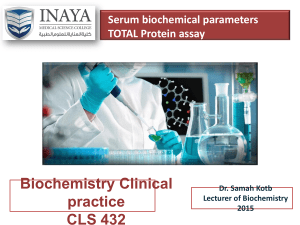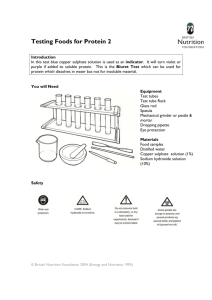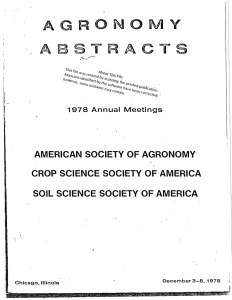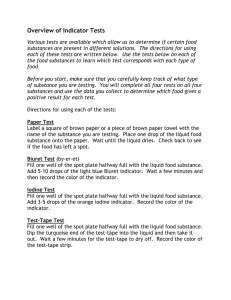Document 12787438
advertisement
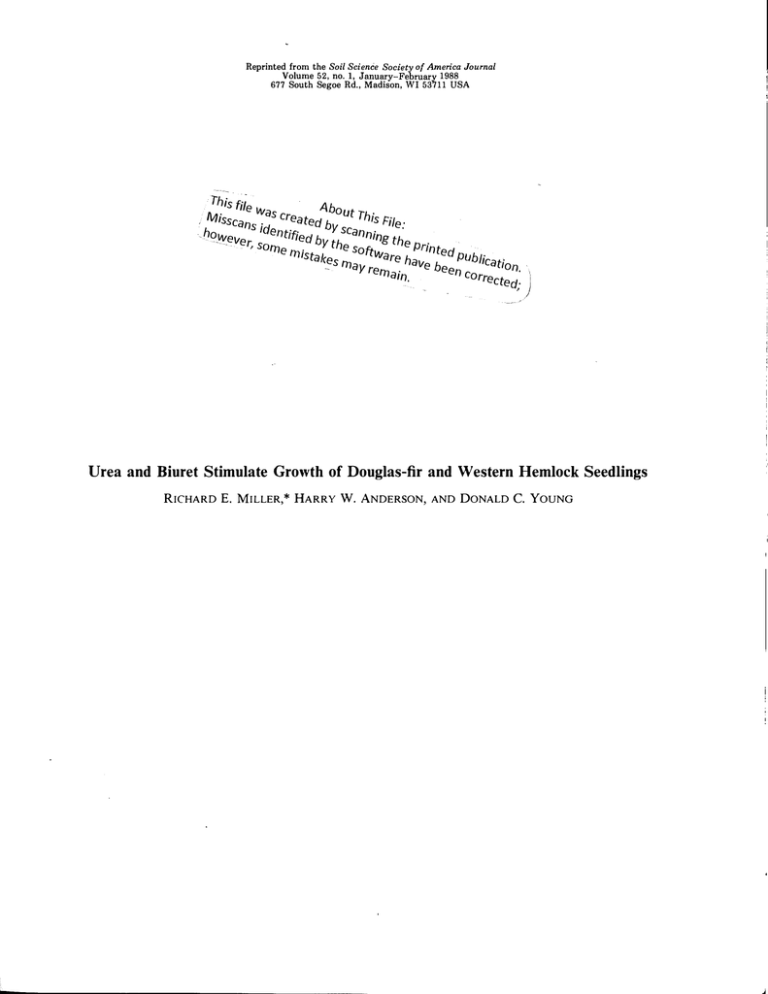
Reprinted from the Soil Science Society of America Journal Volume 52, no. I, January-February 1988 677 South Segoe Rd., Madison, WI 53711 USA rhis fi/ Abou Was c t rhl. reate s Fil . can d . e bY sc .· d e I . +:· ann ' s n h t· o rn -'. ,W-ev Ille'd b mg . . er, t he Y t he s om Pnnt soft e ed P w s a t I akes re hav Ublica tio ma e be en c y rem ai orrec n. te l'VIiss -. - : ,) Urea and Biuret Stimulate Growth of Douglas-fir and Western Hemlock Seedlings RICHARD E. MILLER,* HARRY W. ANDERSON, AND DONALD C. YOUNG • Urea and Biuret Stimulate Growth of Douglas-fir and Western Hemlock Seedlings RICHARD E. MILLER,* HARRY W. ANDERSON, AND DONALD YOUNG found no published information about susceptibility of conifers to biuret damage. Symptoms of toxic ef­ fects of biuret closely resemble those of high concen­ trations of free NH3 or N02, which can also follow urea fertilization to the soil (Kilmer and Englestad, 1973). Biuret in urea is generally less damaging to plants when applied to the soil than when applied as a foliar spray. For example, biuret concentrations of 2 to 10% in urea fertilizer have been safely applied to the soil of established agricultural crops, whereas biu­ ret concentration of 0.25 to 3% are tolerable for foliar applications (Kilmer and Englestad, 1973). Our objective was to determine if biuret alone or with urea reduced seedling growth of coast Douglas­ fir or western hemlock. Field trials in established stands indicated that hemlock does not respond to ground application of prilled or granular urea as much or as consistently as Douglas-fir does (Peterson and Gessel, 1983). This difference could reflect susceptibility of hemlock to toxicity from biuret in urea fertilizer. ABSTRACT Two experiments were conducted in a greenhouse to test a theory that biuret in urea fertilizer reduces growth of Douglas-fir [Pseu­ dotsuga menziesii (Mirb.) Franco] or western hemlock [Tsuga het­ erophy/la (Raf.) Sarg.]. Newly germinated seedlings in 2.5-L pots were treated with 0, 0.224, 2.24, or 22.4 kg biuret ha I (40% N) in factorial combinations with 0, 84, or 168 kg N ha 1 as reagent-grade urea (46% N). The biuret was applied as a solution to either the sandy loam soil or the foliage. Four of the eight replicates were harvested 203 d after treatment. For Exp. 2, the remaining seedlings were retreated as they were initially and harvested 305 d later. In both experiments, the two species responded strongly to urea; more­ over, seedling dry weight increased with increasing biuret (P 0.003). A veraged over all other factors, weight of seedlings treated with the highest biuret dosage was 14% more than the weight of seedlings with no biuret. Unfertilized hemlock responded as much to 0.2 kg biuret ha 1 (0.08 kg N ha I ) as to 84 kg N ha 1 as urea; this sug­ gests that biuret functions as a hormone. The results indicated that biuret is unlikely to reduce growth of seedlings of either species even when urea heavily contaminated with biuret is applied at high dos­ age. = Additional Index Words: N fertilizer, Pseudotsuga menziesii, Tsuga MATERIALS AND METHODS heterophylla, phytotoxicity, seedling growth. We used newly germinated and l -yr-old seedlings of both species growing in pots in a greenhouse to quantify phyto­ toxicity of various dosages of biuret that were applied to either foliage or soil and in factorial combinations with three dosages of N. Approximately 2.5 kg of Tumwater fine sandy loam (mixed, mesic Dystric Xeropsamments; pH, 5.6; organic matter, 24 g kg I; total N, 0.7 g kg I ) were placed in each of 384 2.5-L pots.' We chose this soil because a large state­ owned tree nursery is located on this soil and it is N deficient (Radwan and DeBell, 1980; Radwan et aI., 1979). Following random assignment to either Douglas-fir or western hem­ lock, each pot was sown on 17 May with 10 previously strat­ ified seeds of one species. Approximately 16 h of light per day was provided; natural light was supplemented by sea­ sonally using fluorescent lamps. Greenhouse temperatures were maintained between 10 and 32 °C and soil moisture was maintained near field capacity. Eighty-three days after sowing, seedlings were thinned to five per pot to achieve uniform spacing and height, and 24 different treatments were randomly assigned to each species. The 24 fertilizer treatments for each species were arranged as a 4 X 2 X 3 factorial that tested four levels of biuret (0, 0.224, 2.24, and 22.4 kg ha I ) , two methods of biuret ap­ plication (solution poured on the soil or sprayed on the fo­ liage), and three levels of N (0, 84, or 168 kg ha 1 as urea). Fertilizer dosages per hectare were proportional to the area of the potted soil surface. The 48 treatment X species com­ binations were initially replicated eight times. All solutions were prepared from reagent-grade urea or biuret and were first applied when the 60-d-old Douglas-firs were 2- to 6-cm tall and the hemlocks were 1- to 2-cm tall. Biuret applied as a 10 g kg 1 solution; dosage was increased by using more solution either poured or pumped (with a manual sprayer) from a graduated cylinder. In the initial application, some solution was inadvertently sprayed directly on the soil be­ cause the spray missed or dripped from the sparse foliage; however, little, if any, spray was lost from the plant-soil area. REA FERTILIZER contains small but variable U amounts of biuret, the result of high tempera­ tures used during manufacture of the fertilizer. Biuret and NH3 form from urea when urea is maintained in the molten state: 2(NH2• CO·NH2}....... (NH2 CO· NH . CO·NH2) + NH3. Although urea fertilizer produced in modern facilities generally contains 0.3 to 2.0% biu­ ret, concentrations exceeding 5% have been measured in some batches (Kilmer and Englestad, 1973). Thus, a typical forest application of 224 kg N ha-I as urea (46% N) generally would include 1.5 to 9.7 kg biuret ha-', and occasionally as much as 24.4 kg ha-I if urea containing 5% biuret was used. Plants can absorb biuret through their roots and leaves, but metabolize it slowly, if at all (Kilmer and Englestad, 1973). Following mineralization by soil mi­ crobes, biuret is a readily available N source for plants. Biuret does not retard the hydrolysis of associated urea but does inhibit conversions of NH4 to N02 and of N02 to N03 (Sahrawat, 1977). Although biuret is re­ portedly phytotoxic, plants vary in their susceptibility to biuret injury (Commonwealth Agricultural Bur­ eaux, 1977). For example, critical levels of biuret ap­ plied to the soil were 3 to 4 kg ha -I and over 15 kg ha- I for potato (Solanum tuberosum L.) and maize (Zea mays L.), respectively (Gadet et aI., 1959). We • R.E. Miller, USDA-FS, Forest Science Lab.. Olympia, WA; H.W. Anderson, Washington State Dep. of Natural Resources, Olympia, WA; and D.C. Young, Unocal Science and Technology Div., Brea, CA. Contribution from the USDA-FS, Pacific Northwest Res. Stn., Olympia, WA 98502. Received 23 June 1986. *Corresponding au­ thor. Published in Soil Sci. Soc. Am. J. 52:256-260 (1988). C. 256 257 MILLER ET AL.: DOUGLAS-FIR AND WESTERN HEMLOCK SEEDLINGS After the first growing season (203 d after treatment), four of the eight replicates were randomly selected for harvest and were designated as Exp. 1. The remaining replicates were designated as Exp. 2; these were immediately rethinned to three seedlings per pot and refertilized to test the effects of' large cumulative dosages of biuret. Refertilization of each pot equalled the original fertilization, thus the experimental design for both experiments was the same. Seedlings of Exp. 2 were tended the same as those in Exp. 1 and harvested 305 d after retreatment. Treatments were evaluated on the basis of dry wt. of roots, tops, their ratio, and plant total. Weight of tops and roots was determined follo)Ving washing and drying at 105°C to constant weight. Average seedling weight per pot was com­ puted on the basis of the number of surviving seedlings; i.e., five (Exp. 1) or three seedlings (Exp. 2) in almost all pots. The data were subjected to analysis of variance using or­ thogonal polynomials to compare regressions of average seedling weight per pot against N or biuret dosages. The main effects of the four factors (species, N dosage, biuret dosage, and application method) and their interactions were analyzed as a completely random design. Means were judged statistically significant when P :;:: 0.05. The statistical analyses estimated and compared the re­ sponse surfaces for N (three levels) and for biuret (four lev­ els). In some analyses, statistically significant interactions involving N or B (biuret) had a difef rent curve form than that of the main effects of N or B. We questioned if the surface identified by the main effect should limit the curve form of the interaction. For example, when the main effect of biuret was linear, should a statistically significant inter­ action involving a quadratic B effect be considered as a true effect? Although the general answer is yes, limitations in experimental design may preclude a valid estimate of a quadratic or higher-order form. Thus, we considered that our three levels of N were inadequate for fitting a quadratic surface because the quadratic polynomial will fit the three points exactly and will leave no measure of lack of fit around the regression (John Hazard, 1978, personal communica­ tion). Because of these considerations, we ignored quadratic surfaces for N but accepted them for biuret. RESULTS To condense the results of factorial analyses of the four growth parameters (total seedling weight, top weight, root weight, and top/root ratio), we provide 2.5 :§ .. .c C) 'iii 3: iii ...0 ... C IV GI ::! 0 l df Total Top/root Total Top/root Species 1 2 (1) 3 (1) 1 1 *** *** *** *** *** *** *** *** NS NS NS N N, (linear) Biuret B, (linear) Application SxN SxB, SxA NxA SxNxB SxNxA = 84 0 N dosage (kg ha-1) = ** NS NS NS *** NS NS NS NS NS NS NS * = = = Total Weight After one growing season, Douglas-fir seedlings were 1.6 times heavier than hemlock seedlings. Although average total weight of both species increased with increasing N dosages (Fig. 1); Douglas fir was more responsive than hemlock to N fertilization (Table 1). Seedling weight of both species was increased by the lowest biuret dosage, 0.224 kg ha - I; little additional increase in seedling weight accompanied 10- and 100 fold increases in biuret (Fig. 2). Having no statistically significant interactions of the other factors with biuret (Table 1), one may generalize over all levels of the other factors: seedlings receiving biuret were heavier than those without; at the highest biuret dosage (22.2 kg ha - I), seedlings averaged 14% heavier. 1.0 C IV GI I I • . Douglas-fir Hemlock • • ::Il 0.5 168 Fig. 1. Mean total oven-dry weight of Douglas-fir and hemlock seed­ lings, as affected by N dosage (Exp. 1). Each species-N dosage combination pools four biuret dosagesxtwo application methods ' 32 pots. SE 0.045 g. x four replicates = NS NS NS NS NS NS NS Experiment 1: Fertilization of 60-d-old Seedlings ...o ... Hemlock * tables, figures, and text featuring treatment effects on total seedling weight and top/root ratio. Treatment effects on top and root weight were similar to those on total weight. GI ----- * = 3: iii - *** NS NS NS ** * ,**,*** Significant at the 0.05, 0.01. and 0.001 probability levels, respectively. t S species, N nitrogen, B biuret. and A application (soil or foliage). :j: NS nonsignificant. .f!! - * NS 1 1 1 3 1 (quadratic) ... .c - E xp. 2 Factort m 1.5 1.5 0.5 Seedling weight Exp.l 2.0 2.0 1.0 Table 1. Experimental factors and their interactions that were significant (P :s 0.05) in Exp. 1 and 2. o 0 20 15 10 5 Biuret dosage (kg ha-1) 25 Fig. 2. Mean total oven-dry weight of Douglas-fir and hemlock seed­ lings, as affected by biuret dosage (Exp. 1). Each species-biuret dosage combination pools three N dosagesx two biuret applica­ tion methods x four replicates 24 pots. SE 0.05 g. = = 258 SOIL SCI. SOc. AM. 2.0 Cl 1.5 Cl .; tV ... 0 ... C nl Q) 1., VOL. 52, 1988 0 1.0 (5 e a. 0 I- 0.5 1.5 1.0 0.5 N dosage (kg ha-1) Fig. 3. Mean total oven-dry seedling weight, as affected by N dosage and method of applying biuret (Exp. 1). Each application-N dos­ age combination pools four biuret dosages x two species x four replicates 32 pots. SE 0.045 g. = = The N X A interaction (N dosage X application method) was statistically significant. Thus, depending on the N dosage, the two methods of applying biuret significantly differed in their effects on seedling weight. Seedlings that received 0 and 84 kg N ha I and that also received biuret as a soil application were slightly heavier than those treated with foliar spray. When combined with 168 kg N ha I, however, soil appli­ cation of biuret slightly depressed the response of both species to this high dosage of N (Fig. 3). Top/Root Ratio Relative changes in top and root weights during the first growing season are expressed by the ratio of top/ root weight. Significant interactions indicated that the top/root ratio of the two species differed in response to N dosage and to method of biuret application (Ta­ ble 1). Although top weight of both species increased more than root weight with increasing N dosage (Fig. 4), the top/root ratio of hemlock increased more than that of Douglas-fir. Nitrogen fertilization strongly stimulated top growth of hemlock, but had little effect on root weight. N applied, kg ha I Species 168 0 84 root weight, g Douglas-fir 0.88 0.45 0 . 76 Hemlock 0.28 0.22 0.27 Both species also differed in their response to the method of applying biuret. As tabulated below, top growth (relative to root) of Douglas-fir was slightly stimulated only by foliar application of biuret, whereas hemlock responded more to soil application. Species Douglas-fir Hemlock Biuret application Foliage None Soil -----top/root ratio----1.48 1.40 1.32 1.92 1.85 2.25 0 0 N 168 64 dosage (kg ha-1) Fig. 4. Mean top/root weight ratio as affected by N dosage (Exp. 1). Each species-N dosage combination pools four biuret dosages x two application methods x four replicates 32 pots. SE 0.084. = = Experiment 2: Refertilization of l-yr-old Seedlings Total Weight Species and N were significant in both their main effects and their interaction, but a significant three­ way interaction with A (application method) pre­ cluded generalizations (Table I). Thus, total weight of both species increased linearly with cumulative N dos­ age; foliar application of biuret depressed response of Douglas-fir to N, whereas soil application depressed response of hemlock to N (Fig. 5). From the combined efef cts of the first and second treatments, average weight of both species increased linearly with increasing biuret dosage (Fig. 6). As in Exp. 1, seedlings treated with the highest biuret dosage (44.8 kg ha I in Exp. 2) averaged 14% heavier than seedlings that received no biuret . This generalization about the stimulating effect of biuret held for both species and to both methods of applying biuret be­ cause the SX Band BX A interactions (where S species) were nonsignificant. = Top/Root Ratio The decline in top/root ratios after the second grow­ ing season indicated that the three seedlings in each pot collectively increased root weight more than top weight during the second growing season. Species Douglas-fir Hemlock Top/root ratio Year I Year 2 1.39 2.02 1.06 1.21 The top/root ratio was greater for hemlock than for Douglas-fir in both years. Moreover, the average (for both species) trend of top/root ratio and N dosage (1.06:1, 1.10:1, and 1.24:1 respectively for 0, 168, and 336 kg N ha I, respectively) was linear and statisti­ cally significant (Table 1). This significant main effect of N, and nonsignificant interactions, indicated that top growth of both species increased more than root growth with increasing amounts of N. I 259 MILLER ET AL.: DOUGLAS-FIR AND WESTERN HEMLOCK SEEDLINGS 6 Total 5 :§ 4 . 3 .... .t::. ; OL- L-----------------J - ---------------O 3 1 68 N dosage (kg ha-1) 2 --_T=_= _ ______________________.. . . . ._ Roots . _____________ _ _ -___-. . _ _ -__ . -._.. .-_ . . •• '--- .• -- -- ----.... ---------- . . - . . . .. . . 6 5 Fig. 5. Mean total oven-dry weight of Douglas-fir (DF) and hemlock (H) seedlings as affected by cumulative N dosage and method of applying biuret (Exp. 2). Each species-N dosage-application method combination pools four biuret dosages x four replicates 16 pots. SE 0.29 g. 15 25 35 Cumulative biuret dosage (kg ha 45 -1) Fig. 6. Mean oven-dry seedling weight. as affected 5y two cumulative biuret dosages (Exp. 2). Each biuret dosage pools two species x three N dosages x biuret application o methods of x four re licates tw 4 pots. SE g ( otal weight); SE .17 g (tops); and SE .10 g (roots). = = DISCUSSION = 0'89 = s = Effect of Urea In both experiments, addition of reagent-grade urea solution to this fine sandy loam soil clearly stimulated growth of both species. The N response surfaces were linear for total seedling weight, top weight, and root weight; however, N stimulated top growth more than root growth. The initial applications of 84 and 168 kg N ha I increased growth of 60-d-old Douglas-fir more than hemlock. Tpe initially slower growth and devel­ opment of hemlock compared to Douglas-fir probably explains its slower response during the first growing season. tors of both experiments, the highest biuret dosage (22.4 and 44.8 kg ha I in Exp. 1 and 2, respectively) increased growth about 14%. Unexpectedly, soil ap­ plication of biuret to unfertilized hemlock seedlings in both experiments was especially stimulating. Soil application of biuret depressed response of both species to a concurrent fertilization with 168 kg N ha I in Exp. 1 (Fig. 3) and response of hemlock to N in Exp. 2 (Fig. 6). This reduced response to urea could be explained by biuret either increasing salt concen­ tration in the soil or inhibiting conversion of NH4 to NO, or NO, to N01• These inhibitions can lead to NH; or NO toxicity (Court et aI., 1964; Sahrawat, 1977). For example, Sahrawat (1977) reported N02 accumulation in a sandy loam soil when the biuret Effect of Biuret and Method of Application Biuret generally stimulated growth of both species, but especially of hemlock. Averaged over all other fac- Table 2. Mean seedling weight and weight gains with specified N dosage from biuret (B) or urea (U) sources. Douglas -fir N dosage Source Applied to kg ha-' Mean seedling weight g Hemlock Weight gain/N gt Mean seedling weight Weight gain/N Rel.:j: g gt Rel.:j: -44 78 17 -13 0.1 1.4 1.0 0.7 0.36 0.86 0.47 0.54 0.44 0.94 0.50 0.75 0.95 5.56 1.22 0.20 0.089 0.064 0.Q16 0.005 0.004 1110 244 40 18 13 3.2 1.0 0.8 -190 31 -26 -32 2.4 1.4 1.0 1.1 0.65 1.89 0.74 1.62 0.74 2.17 1.60 4.34 8.69 6.89 0.50 0.54 0.050 0.084 0.053 0.022 0.024 310 23 25 2.3 3.8 2.4 1.0 1.1 Exp_ 1 0 0.09 B B 0.90 B 9.00 U U 84 168 0 0.18 B B 1.80 B 18.00 168 336 t Weight gain/N = U U Soil Foliage Soil Foliage Soil Foliage Soil Soil 0_90 0.86 0.97 1.05 0.78 0.89 1.03 1.70 2.15 Soil Foliage Soil Foliage Soil Foliage Soil Soil 2.97 2.43 3.06 2.24 2.04 3.68 3.36 5.60 8.62 -0.44 0.78 0.17 -0.13 0.001 0.014 0.010 0.007 Exp. 2 weight gain over control divided by N dosage. -3.0 0.50 -0.42 -0.52 0.039 0.022 0.Q16 0.017 :j: ReI. = gainiN with 84 and 168 kg N ha-' (Exp. 1 and 2. respectively) = 1.0. 260 SOIL SCI. SOc. AM. J., concentration was only 1% of the pplied urea. B s d on this biuret/urea ratio, the potentIal for N02.tOX CIty clearly existed in five of six . biur t-urea co.mbInatIOns in both experiments. DespIte thIS pot ntIal for N 2 toxicity, only a few seedlings temporanly showed VIS7 ual symptoms of toxicity. . , In Table 2 we compare the relatIve effiCIency of urea and soil:applied or foliar-applied biuret for in­ creasing weight of unfertilized Douglas-fir and hem­ lock seedlings. Total weight of hemlock was clearly . increased by supplying N via biuret (40% N);. soIl ap­ plication of biuret was consistently more .effectIve than foliar application. In contrast, total weIgh of unfer­ tilized Douglas-fir was increased by some bIUret treat­ ments and decreased by others. The weight gain of hemlock s edlings per ilogram of applied N was greater with bIUr t than WIt urea. Yet, our comparisoIl: of urea and .bIUret effectIveness . required an assumptIOn because bIUret was applIed at 1/10 or less of the lower urea dosage. Consequently, we had to assume that N response was linear between o and 84 kg N ha-", our lo er urea ra e in xP. 1 (168 kg in Exp. 2). Based on thIS assumptIOn, b uret as an N source for hemlock was from 2 to 1110 tImes more effective per unit of N than was urea. (Table 2). The high efficiency of biuret, when applIed to hemlock seedlings at the lowest biuret dosage (0.09 and 0.18 kg . N ha - I in Exp. 1 and 2, respectn:ely), suggests a non­ nutritional or hormonal effect from biuret. The co ­ sistently greater stimulating effect to hemlock of soIl­ applied vs. foliar-appli d biu et i.n the absence of u ea fertilizer needs further InveStIgatIOn. Res lts cou d In­ dicate that biuret may be more readIly avaIlable through hemlock roots than through foliage. Extremely large dosages of iuret (22.1 and 44.8 kg ha -I in Exp. 1 and 2, respectIvely) appbed t the f?­ liage of newly germinated and l -yr-old seedlIngs dId not result in the biuret toxicity symptoms of yello.w leaf tips and tip die-back for many plant speCIes (Kil­ mer and Engelstad, 1973). This strongly suggests t at these species are tolerant of biuret. U exp.ected y, bIU­ ret as a single treatment and in COmbInatIOn WIth low or moderate N dosages clearly stimulated hemlock seedling growth. . Relating the results of these greenhouse exper ments to forest fertilization is tenuous (Mead a d Pnt h tt, 1971), but necessary to serye silvic,;!ltuflSts untIl In­ vestigations are conducted In establIshed .stands. We found that biuret applied to the potted soIl and com­ bined with a heavy urea dosage slightly reduced re­ sponse of Douglas-fir and hemlock seedlin s to N; however, levels of biuret commonly found In com­ mercial grade urea would generally be well below the highest dosages used in these experiments. We also found that the l-yr-old seedlings of Exp. 2 showed greater tolerance of larger dosages of biuret and N t.han did new germinants of Exp. 1. We therefore belIeve that growth of established stands of Doug as-fi or . western hemlock or their response to N fertIhzatIOn, is not likely to b reduced by biuret in urea fertilizers. VOL. 52, 1988 CONCLUSIONS 1. Seedling biomass of both species was at least dou­ bled when urea was added to a loamy sand soil. Doug­ las-fir responded more to urea than did hemlock. 2. In unfertilized seedlings, biuret stimulated growth of hemlock, even when excessive dosages were applied to foliage or to the soil. Unfertilized Douglas-fir showed slight but erratic response to biuret; growth slightly increased or decreased depending on biuret dosage and method of application . 3. Unfertilized hemlock responded positively to as little as 0.2 kg biuret ha-' «0.1 kg N ha-'). This small biuret dosage applied to the soil under newly germinated hemlock seedlings stimulated their dry weight more than did 84 kg N ha 1 as urea. Biuret may function as a plant hormone. 4. Excessive biuret applied to the soil and combined with heavy N fertilization reduced response of 60-d­ old seedlings to N, but not response of l-yr-old seed­ lings. The reported inhibiting effect of biuret on NH4 and N02 conversions may explain this reduced re­ sponse to urea. 5. Our experimental levels of biuret exceeded those found in commercial-grade urea; therefore, biuret con­ tamination of urea is unlikely to reduce growth of young seedlings of either species, even where heavily contaminated urea is applied at high dosage. - ACKNOWLEDGMENT The authors thank John Hazard for technical assistance and advice about statistical analyses. Our thanks also to M.A. Radwan, Paul Heilman, Robert F. Powers, and three anon­ ymous people for technical review. REFERENCES Commonwealth Agricultural Bureaux. 1977. Biuret toxicity, 1954­ 1975. Annot. Bibliogr. SB 1862. Harpenden, England. Court M.N. R.C. Stephens, and J.S. Ward. 1964. Toxicity as a cau;e of t he inefficiency of urea as a fertilizer, II. Exp. J. Soil Sci. 15:49-65. Gadet, R., L. Soubies, and F. Fourcassie. 1959. Recherches sur les effets toxiques du biuret et sur l'evolution de ce compose dans les sols. Ann. Agron. 10:609-660. Kilmer, V.J., and O.P. Engelstad. 1973. Crop response to biuret in urea. TVA Natl. Fert. Dev. Cent. Bull. Y-57. TVA, Muscle Shoals, AL. Mead D J and W.L. Pritchett. 1971. A comparison of tree re­ spo se i fertilizers in field and pot experiments. Soil Sci. Soc. Am. J. 35:346-349. Peterson C.E. and S.P. Gessel. 1983. Forest fertilization in the Pacific' Northwest: Results of the regional forest nutrition research project. p. 365-369. In R. Ballard and S.P. Gessel (ed.) IUFRO Symp. on Forest Site and Continuous Productivity. USDA-FS Gen. Tech. Rep. PNW-163. USDA-FS Portland, 9R. Radwan, M.A., and D.S. DeBell. 1980. Effects of different sources of fertilizer nitrogen on growth and nutrition of western hemlock seedlings. USDA-FS Res. Pap. PNW-267. USDA-FS, Portland, OR. Radwan, M.A., J.S. Shumway, and D.S. DeBell. 1979. Effects of manganese and manganese-nitrogen applications on growth and nutrition of Douglas-fir seedlings. USDA-FS Res. Pap. PNW-265. USDA-FS, Portland, OR. Sahrawat, KL. 1977. Effects of biuret content on transformation of urea nitrogen in soil. Soil BioI. Biochem. 9: 173-175.
